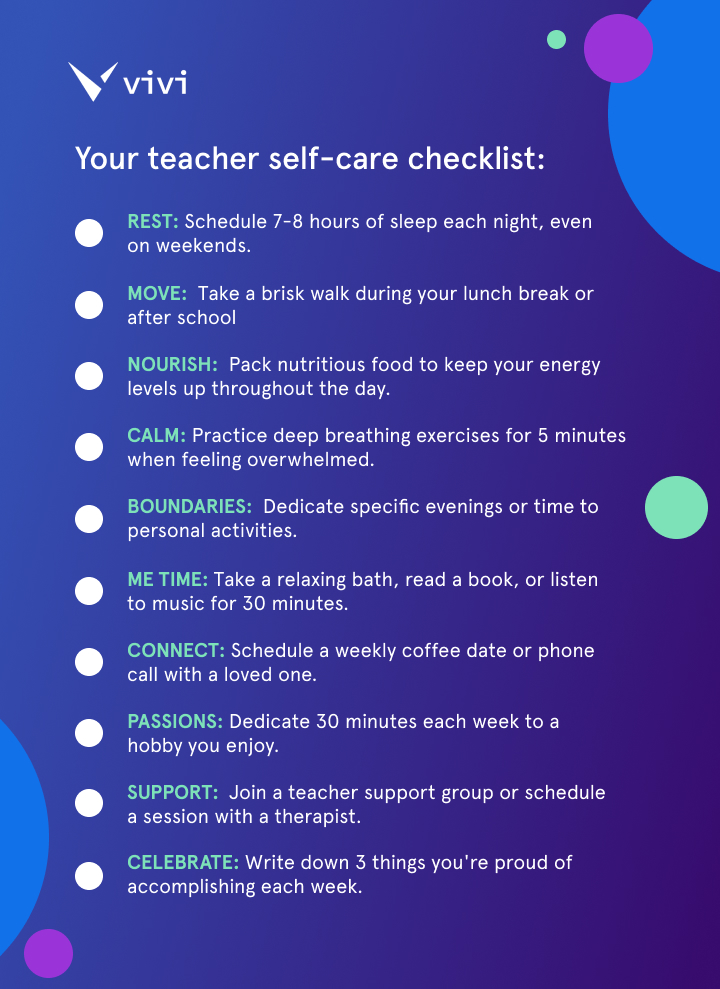
There’s nothing quite like the feeling of igniting a spark of learning in a student’s eyes or witnessing that “aha!” moment of understanding. As educators, you hold a unique and powerful role in shaping young minds and making a lasting impact on the future.
While teaching is incredibly rewarding, it’s also important to acknowledge that it can sometimes be demanding. Prioritizing your well-being is key to feeling energized and engaged in the classroom. Ready to discover practical self-care strategies to make this school year your best yet? Let’s dive in!
Teacher burnout: Understanding the signs and symptoms
What leads to teacher burnout? It’s often a mix of long hours, limited resources, standardized testing pressures, and the emotional weight of supporting students. But how do you know if you’re experiencing it?
Here are some common signs of teacher burnout:
- Emotional exhaustion: Feeling emotionally drained, overwhelmed, and depleted.
- Cynicism and detachment: Feeling negative, disillusioned, or distant from your students and colleagues.
- Reduced personal accomplishment: Feeling ineffective, doubting your abilities, and experiencing a lack of accomplishment.
- Physical symptoms: Experiencing fatigue, insomnia, headaches, changes in appetite, or a weakened immune system.
- Mental health concerns: Increased anxiety, depression, or irritability.
- Decreased job satisfaction: Feeling dissatisfied with your work, lacking motivation, and dreading going to school.
Recognizing these signs is crucial. Addressing burnout early can help protect your well-being and your passion for teaching.
How to create a teacher self-care plan
Just like you personalize learning for your students, create a self-care plan that works for you. This is your toolkit for combating burnout and staying energized!
Here are some key areas to focus on:
Physical well-being:
- Sleep: Aim for 7-8 hours of quality sleep each night.
- Nutrition: Fuel your body with nutritious meals and healthy snacks.
- Exercise: Incorporate regular physical activity into your routine.
Professional well-being:
- Support: Reach out to colleagues, mentors, or a therapist for guidance.
- Growth: Engage in professional development that excites you.
- Celebrate: Acknowledge and appreciate your accomplishments.
Emotional well-being:
- Mindfulness: Explore techniques like meditation or deep breathing.
- Mindful boundaries: Set aside time for mindfulness to maintain your peace.
- Connection: Enhance well-being by engaging in mindfulness exercises with peers.
Discover a calmer, more focused classroom environment! See how pairing Vivi with Headspace can enhance both teaching and learning experiences.
Your self-care action plan: Putting it into practice
Now that you’ve explored some key self-care strategies, it’s time to put them into action! Remember, even small changes can make a big difference in how you feel. Choose a few strategies that resonate with you and commit to incorporating them into your daily or weekly routine.
Self-care is crucial for educators. Use the checklist below as a foundation to tailor your self-care routine, assessing what you currently practice and what you might add.

Don’t be afraid to experiment and adjust your plan as needed. The most important thing is to find what works best for you and to make self-care a non-negotiable part of your routine.
Taking care of yourself: A teacher’s key to success
Prioritizing your well-being isn’t a luxury, it’s essential for thriving as a teacher. By managing stress and nurturing yourself, you’ll feel more energized, engaged, and able to create a positive learning environment for your students.
Remember, self-care is an ongoing journey. Commit to small, consistent actions and build a supportive network to navigate the demands of teaching with greater resilience and joy.
You deserve to feel your best, both inside and outside the classroom. Choose one self-care strategy to focus on today and start building a more sustainable and fulfilling teaching career. You’ve got this!



